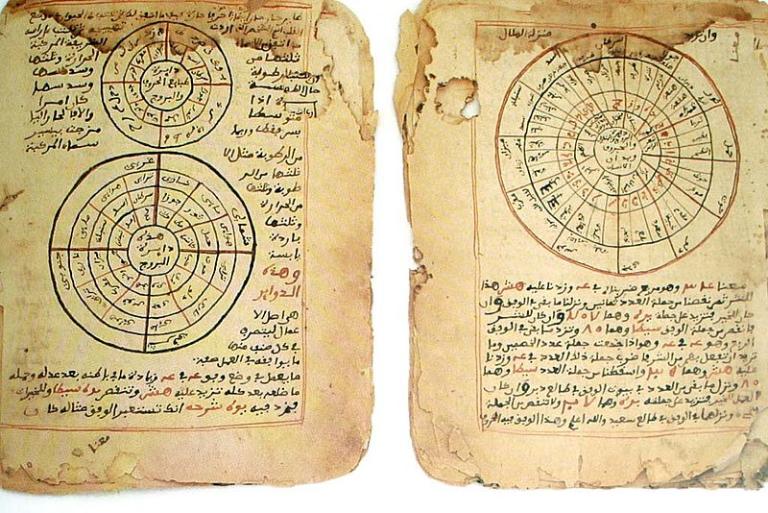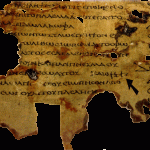
(Wikimedia Commons public domain image)
Arab and other Muslims had very practical reasons for their interest in mathematics. The calculation of the precise direction of the qibla (the direction of prayer to Mecca), something that was required for the proper orientation of mosques, relied upon rather sophisticated mathematical operations. So did the calculation of the exact date of the holy fasting month of Ramadan. (Being a lunar month, Ramadan moves through the seasons. Sometimes it occurs in winter, sometimes summer, sometimes fall or spring.)
The exact reckoning of inheritance according to detailed Qur’anic rules needed attention. And the hajj, the pilgrimage to Mecca, had tens or even hundreds of thousands of Muslims converging upon the holy cities of Arabia from all corners of the globe, by land and by sea. This was an operation that required navigational skills of the highest order.
However, unlike the ancient Egyptians before them, the Arabs did not limit their mathematical investigations to merely practical matters. Their work went far beyond utilitarian purposes. They made significant contributions, for example, to trigonometry and spherical geometry. It was an Arab, al-Khwarizmi (d. 850), who invented the technique of using letters and other non-numerical symbols to represent numerical values that we know as “algebra.” In fact, the very term algebra comes from the title of one of al-Khwarizmi’s books. He used the word al-jabr to mean `joining,” that is, “joining” mathematical quantities together in equations; it originally pertained to “joining” or “setting” broken bones. Al-Khwarizmi’s name itself shows up in Western mathematics, in a distorted form, as the term algorithm, which denotes a system of rules or a process for calculations. (Algorithms have become especially important in our age of electronic calculators and computers.)
It was also from al-Khwarizmi that the West learned of Arabic numerals. However, the transfer took a while to occur, since his work had to wait three centuries before being translated by an Englishman named Abelard of Bath. And it was only after considerable objection that Arabic numerals were finally adopted by Europe in the thirteenth century. Europeans found the Arabs’ notion of “zero” especially amusing. It was, they said, “a meaningless nothing.” Why have a symbol for nothing at all? But eventually even Europeans began to recognize that these numerals, and the idea of the place system that accompanied them, had certain advantages over Roman numerals. (Try, just as an experiment, to do long division or multiplication with MDCCCXLVIII and CDXIV instead of 1848 and 414! You will soon see why the Europeans eventually gave up their resistance.) Today, our words cipher and decipher and even zero itself come from the Arabic term for “emptiness” or “nothingness,” sifr.
Gradually, as the West noticed the riches that were available in Arabic scientific and mathematical writings, the pace of translation picked up. “From the second half of the eighth to the end of the eleventh century,” writes the great historian of science George Sarton, “Arabic was the scientific, the progressive language of mankind… When the West was sufficiently mature to feel the need of deeper knowledge, it turned its attention first of all, not to Greek sources, but to the Arabic ones.”[1] A “College of Translators,” established at Toledo in the high Middle Ages and functioning very much along the lines of the earlier House of Wisdom at Baghdad, was instrumental in transmitting Arab science to the West. This fact left its own mark upon Western mathematics, as a simple illustration will show:
We commonly use the letter x to represent an unknown quantity. Originally, this was merely the practice in algebra and mathematics, but it eventually entered into everyday life, where we speak of things like Brand X. How did we come to choose the letter x for this? Why not some other letter? Well, as you might have begun to suspect, this habit comes in a roundabout way from Arabic. Older Spanish and Portuguese spelling used the letter x to represent what we in English know as the sh sound. It so happens that the word for “thing” or “something” in Arabic is shay. Thus, when the Spanish and Portuguese translators who transmitted Arabic mathematics to the West wanted an easy-to-write symbol that stood for an unknown quantity, they simply took the first letter of the Arabic word for “something.”
Now is the time, perhaps, to mention the immense influence of Arabic on the Spanish language itself. As I have said, there was an important Arab presence in Spain and Portugal for nearly 800 years, from 711 A.D. to the year 1492. It is not surprising, in view of this long contact between the Arabs and the Iberian Peninsula, that many place names on the peninsula are clearly derived from Arabic. When we say that something is “as solid as the rock of Gibraltar,” we are speaking at least some fractured Arabic, for the name Gibraltar is a distorted memory of the Arabic phrase jabal al-Tariq, meaning “al-Tariq’s mountain.” Many of those place names were actually carried into the New World by the conquistadors. One common element that appears frequently is the Arabic word wadi (“valley”). In the corrupt form of Guad-, it appears as a part of numerous place names both in Europe and in the Americas. The beautiful Mexican city of Guadalajara comes immediately to mind, but it is merely one example among many. In Spain itself, there is Guadalquivir—from the Arabic phrase al-wadi al-kabir (“the big valley”).[2] Other Spanish words also come directly from Arabic, such as alcalde (“mayor”), which recalls the old office of al-qadi, “the (religious) judge.”[3]
Such influence through Spanish is yet another way that the Arabs have had impact on the West, and particularly on the American West and Southwest where many of the readers of this book no doubt live. I myself graduated from a school in the Alhambra High School District in southern California, not realizing at the time that the Alhambra was a famous Arab palace in the south of Spain. (Al-qasr al-hamra means “The Red Castle.”) The adjacent town was actually called Alhambra, and one of the town’s streets, Almansor, was named after a great Arab ruler of Spain known as al-Mansur.[4]
[1] George Sarton, Introduction to the History of Science. [???]
[2] Pronounced “al-WAH-dee al-kuh-BEER.”
[3] Some have thought that the Spanish usted might come from the Arabic ustadh, an honorific form of address meaning “master” (or, in contemporary Arabic, “professor”). This is probably not true.
[4] Pronounced “al-Man-SOOR.”












